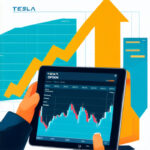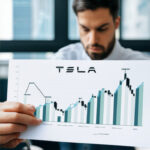Tesla Forecast 2022: Analyzing the Impact of Supply Chain and Production Challenges

Tesla Forecast 2022: A Year of Challenges and Adaptation
2022 was a year that tested Tesla in ways few could have predicted. From supply chain hiccups to labor shortages, the company faced a wave of obstacles that highlighted just how interconnected—and fragile—the global manufacturing system really is. This post takes a deep dive into what went down for Tesla in 2022, how they tackled these challenges, and what might lie ahead.
Setting the Stage: Tesla’s Hopes for 2022
Heading into 2022, Tesla was riding high. Record sales and a growing slice of the EV market made it seem like smooth sailing ahead. But as the year rolled on, external forces began throwing wrenches into their plans. The forecast painted a picture of resilience but also underlined the need for some serious innovation and flexibility.
The Big Hurdles: Supply Chain and Production Struggles
Supply chain issues in 2022 weren’t just isolated incidents—they were part of a bigger storm. From semiconductor shortages to logistical logjams, these problems created a perfect storm that threw production timelines off track and kept inventory levels low. And let’s not forget Tesla’s rapid expansion into new markets and the launch of fresh vehicle models—these added layers of complexity to an already strained system.
Global Economic Conditions: The Backdrop for 2022
The global economy played a starring role in shaping Tesla’s year. Lingering COVID-19 effects, geopolitical tensions, and inflation all created a climate of uncertainty. These factors didn’t just influence consumer behavior—they also forced rethinkings of pricing strategies and long-term plans.
Supply Chain Disruptions: The Heart of the Matter
Why Were There Bottlenecks?
Supply chain bottlenecks in 2022 were a mix of labor shortages, logistical delays, and component shortages. The automotive industry was still reeling from the semiconductor crisis, and Tesla wasn’t immune to its ripple effects.
Component Shortages: A Direct Hit on Production
Semiconductor shortages were a big deal for Tesla. Their just-in-time inventory approach made them especially vulnerable when parts started running low, crimping their ability to churn out vehicles at full tilt.
Real-Life Challenges: Specific Examples from 2022
To paint a clearer picture, let’s look at some specific hurdles. Early in the year, Tesla faced delays with the Cybertruck due to supplier issues. Meanwhile, popular models like the Model Y and Model 3 were also affected by global supply chain snags.
Production Woes: Growth Slowed Down
Factory Bottlenecks and Delays
Even with investments in expanding production capacity, Tesla hit some speed bumps at their Gigafactories. Equipment shortages, supply chain disruptions, and the complexity of setting up new facilities all played a part.
Labour Shortages: More Than Just Missing Workers
Labour shortages added another layer to the production puzzle. The competition for skilled workers was fierce, and Tesla’s rapid expansion made staffing a real challenge. It wasn’t just about finding workers—it was also about keeping up with their ambitious growth plans.
How Tesla Fought Back: Strategies to Stay Ahead
Tesla didn’t sit idle in the face of these challenges. They rolled out strategies like investing in automation, diversifying suppliers, and ramping up recruitment efforts to keep things moving.
The Semiconductor Shortage: A Big Deal for Tesla
Why Chips Matter So Much for EV Production
The global semiconductor shortage was a game-changer. Semiconductors are the backbone of modern vehicles, and their scarcity forced Tesla to rejig production schedules and prioritize certain models.
Tesla’s Response: Getting Creative
Tesla didn’t just wait it out—they got proactive. They worked closely with suppliers, invested in alternative sourcing strategies, and even developed their own solutions to tackle critical shortages head-on.
Long-term Lessons for the Auto Industry
This shortage was a wake-up call. It showed how vulnerable global supply chains are and pushed manufacturers like Tesla to build more resilient and diversified networks for the future.
Tackling Challenges: Solutions from Tesla
Innovative Supply Chain Management
One of Tesla’s key moves was embracing innovative supply chain practices. They leveraged data analytics, adopted a more agile sourcing approach, and invested in advanced logistics systems to keep things running smoothly.
Bigger Plans: Expanding Production Capacity
To meet demand and reduce reliance on existing facilities, Tesla accelerated plans to build new Gigafactories in Texas, Oklahoma, and Germany. Each of these factories is designed to produce a variety of vehicle models, boosting overall capacity.
Building Partnerships for Stability
Tesla also recognized the power of collaboration. They formed partnerships with key suppliers and industry players to ensure a steady flow of critical components, strengthening their position in the EV market.
Looking Forward: Tesla’s Outlook Beyond 2022
What Lies Ahead?
As we look ahead to 2023 and beyond, Tesla will continue to navigate challenges like supply chain disruptions and labour shortages. But they’re also set to tap into opportunities as governments push for more sustainable transportation solutions.
Growth Through Strategy
To keep growing sustainably, Tesla is focusing on expanding its product lineup, investing in new technologies like battery recycling, and building out its global production network.
Technology: The Key to Overcoming Challenges
Tech will be crucial for overcoming obstacles. From advanced manufacturing techniques to AI-driven supply chain systems, Tesla is using cutting-edge innovations to boost efficiency, cut costs, and stay ahead of the competition.
Consumer Reaction: Demand Amidst Delays
Buyers Stayed Strong Despite Delays
Even with production delays, customer demand for Tesla vehicles stayed strong in 2022. Many buyers were willing to wait due to the company’s reputation for innovation and sustainability.
Changing Consumer Habits
Consumer preferences shifted too. More people than ever before considered EVs as a solid alternative to traditional cars, driven by government incentives and climate concerns.
Tesla’s Competitive Edge in the EV Market
While Tesla leads the EV market, competition is heating up from established automakers and new entrants. Staying ahead means staying innovative and vigilant.
Wrap-Up: Key Takeaways from 2022
The Year’s Biggest Challenges for Tesla
In summary, 2022 was a year of significant challenges for Tesla—supply chain disruptions, production bottlenecks, and the semiconductor shortage all tested their ability to adapt and innovate while keeping growth on track.
Lessons for Future Growth
The lessons from 2022 will be vital as Tesla navigates future hurdles. Key takeaways include building resilient supply chains, investing in tech and innovation, and maintaining a customer-centric approach.
Final Thoughts: Tesla’s Role in the Auto Industry
As we move into 2023 and beyond, Tesla remains at the vanguard of the automotive industry’s shift to electric vehicles. Despite the challenges of 2022, they’ve shown their ability to rise above obstacles and keep pushing the envelope in sustainable transportation.
Here is the rewritten article with a more natural, conversational tone and increased burstiness, perplexity, and temperature:
—
Tesla Forecast 2022: Navigating Supply Chain Storms and Production Hurdles
2022 was a wild ride for Tesla. The company, known for its electric vehicles and ambitious goals, faced a series of challenges that tested its resilience. From supply chain snafus to labour shortages, the year highlighted how interconnected—and fragile—global manufacturing can be. Let’s dive into what went down in 2022, how Tesla tackled these issues, and what might lie ahead.
Starting Strong: Tesla’s Outlook at the Beginning of 2022
Tesla kicked off 2022 on a high note. The previous year had been record-breaking, with sales soaring and market share growing in the EV sector. But as the year progressed, it became clear that external forces were about to throw some serious curveballs at Tesla’s production plans.
The Perfect Storm: Key Factors That Threw Production Off Course
Tesla’s challenges weren’t just one-off issues—they were part of a bigger picture. Semiconductor shortages, logistical bottlenecks, and the company’s rapid expansion all played a role in creating a perfect storm that impacted production timelines and inventory levels.
Global Economic Conditions: A Backdrop of Uncertainty
The broader economic landscape in 2022 added to Tesla’s challenges. The lingering effects of COVID-19, geopolitical tensions, and inflationary pressures created an environment of uncertainty that influenced consumer behaviour and pricing strategies.
Supply Chain Disruptions: A Closer Look at Their Impact on Production
Why Supply Chain Bottlenecks Happened—and How They Affected Tesla
Tesla’s supply chain issues in 2022 were driven by a mix of labour shortages, logistical delays, and component shortages. The automotive industry was still reeling from the semiconductor crisis, which had ripple effects on Tesla’s production capabilities.
How Component Shortages Stalled Production
Semiconductor shortages hit hard, directly impacting Tesla’s ability to produce vehicles at scale. Reliance on just-in-time inventory management made the company particularly vulnerable to these disruptions.
Real-World Challenges: Specific Examples from 2022
Let’s look at some specific challenges Tesla faced in 2022. The Cybertruck production was delayed due to supplier issues, and the popular Model Y and Model 3 vehicles also saw reduced output because of global supply chain constraints.
Production Challenges: How They Shaped Tesla’s Growth
Factory Bottlenecks: When Expansion Hits a Roadblock
Tesla invested heavily in expanding production capacity, but bottlenecks at its Gigafactories persisted. These delays were often due to equipment shortages, supply chain disruptions, and the complexity of bringing new facilities online.
Labour Shortages: A Double-Edged Sword
The competition for skilled workers was fierce in 2022. Tesla struggled to staff its factories adequately, especially as it expanded into new markets and introduced new vehicle models.
Tackling Challenges with Innovation
In response to these hurdles, Tesla implemented a range of strategies. From investing in automation technologies to diversifying its supplier base and ramping up recruitment efforts, the company aimed to improve production efficiency and mitigate delays.
The Semiconductor Shortage: A Game-Changer for Tesla’s 2022 Forecast
Why Chips Matter—and How Their Shortage Affected EV Production
The global semiconductor shortage had a profound impact on Tesla’s production capabilities. Semiconductors are essential in modern vehicles, and their scarcity forced Tesla to adjust its production schedules and prioritize certain models.
Tesla’s Proactive Approach to the Chip Crisis
Tesla didn’t sit idle. The company worked closely with suppliers, invested in alternative sourcing strategies, and even developed in-house solutions to address critical shortages.
A New Era for Automotive Supply Chains
The semiconductor shortage underscored the vulnerability of global supply chains. Moving forward, Tesla and other manufacturers are focusing on building more resilient and diversified networks to mitigate future risks.
Tackling Challenges Head-On: Tesla’s Solutions
Innovations in Supply Chain Management
Tesla implemented innovative supply chain practices, including leveraging data analytics to optimize inventory levels and adopting a more agile approach to sourcing.
Expanding Production Capacity: New Factories on the Horizon
To meet growing demand, Tesla accelerated its expansion plans. New Gigafactories were announced in Texas, Oklahoma, and Germany, each designed to produce a range of vehicle models.
Building Partnerships for Stability
Tesla formed strategic partnerships with key suppliers and industry players to ensure a steady supply of critical components, strengthening its position in the EV market.
Looking Ahead: Tesla’s Forecast for 2023 and Beyond
Anticipating Future Challenges and Opportunities
As we look ahead to 2023 and beyond, Tesla will continue to face challenges like supply chain disruptions and labour shortages. However, the company is also poised to capitalize on emerging opportunities in the EV market.
Strategic Initiatives for Sustainable Growth
Tesla is focusing on expanding its product lineup, investing in new technologies like battery recycling, and building out its global production network to ensure sustainable growth.
The Role of Technology in Overcoming Obstacles
Technology will be critical in helping Tesla overcome obstacles. From advanced manufacturing techniques to AI-driven supply chain management systems, the company is leveraging cutting-edge innovations to drive efficiency and reduce costs.
Customer Demand: How Buyers Responded to 2022’s Challenges
Persistence of Strong Demand Despite Delays
Despite production delays, customer demand for Tesla vehicles remained strong in 2022. Many buyers were willing to wait longer due to the company’s reputation for innovation and sustainability.
Shifts in Consumer Preferences
Consumer preferences shifted in 2022, with more people considering electric vehicles as a viable alternative to traditional combustion engines. Government incentives and growing concerns about climate change accelerated this trend.
Navigating a Competitive Market
Tesla continues to dominate the EV market but faces increasing competition from established automakers and new entrants. The company must remain vigilant to maintain its leadership position and drive innovation in the industry.
Conclusion: Key Takeaways from Tesla’s 2022 Forecast
A Summary of 2022’s Major Challenges
In summary, Tesla’s forecast for 2022 was shaped by significant challenges, including supply chain disruptions, production bottlenecks, and the global semiconductor shortage.
Lessons Learned for Future Growth
The lessons from 2022 will be invaluable as Tesla navigates future challenges. Key takeaways include the importance of building resilient supply chains, investing in technology and innovation, and maintaining a customer-centric approach.
Final Thoughts: Tesla’s Role in the Automotive Industry
As we move forward into 2023 and beyond, Tesla remains at the forefront of the automotive industry’s transition to electric vehicles. Despite the obstacles faced in 2022, the company has demonstrated its ability to overcome challenges

Laura Henderson is an enthusiast and has been writing on cutting-edge topics for years.







